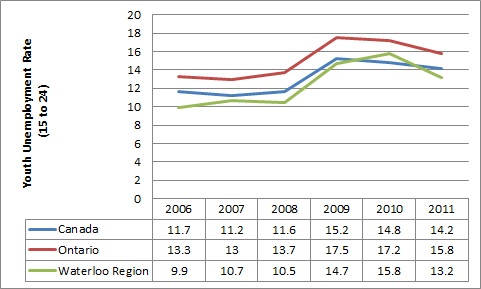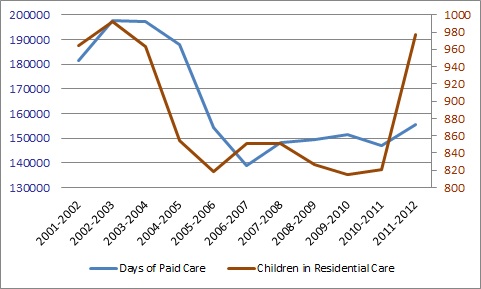Posts Tagged ‘crime prevention’
Posted on: September 4th, 2013 by Waterloo Region Crime Prevention Council
Crime prevention, social capital, neighbourhood cohesion… all the stuff of Jane Jacobs and Mr. Rogers! In this latest episode of “By The Numbers” Anthony Piscitelli pays homage to a certain friendly neighbour in order to give you the highlights of a recent report from the Waterloo Region Crime Prevention Council.
You can find the full report here.
What do you think…. does your neighbourhood have a high level of social capital? Or do you live in a neighbourhood that has a high fear of crime? What does your neighbourhood do to build community and social capital?
I’d love to hear your stories!
Posted on: August 26th, 2013 by Smart on Crime
A couple of years ago I was blessed with the opportunity to volunteer with the vulnerable sector here in Kitchener/Waterloo. Specifically, I volunteered with homeless youth under age 25. During this time I was able to get to know many of the youth and listen to their stories. My very first shift I went home an emotional wreck after having a conversation with a young girl not much older than my own daughter.
It wasn’t long before I became acutely aware of the higher incidence of drug use, mental health problems and criminal activity among this population.
Someone said to me one day, ‘they have a choice, we all have choices.’ My reply was ‘sure we all have choices but we have not all been given the same tools to make good choices. How can I compare myself, who grew up with 2 upstanding parents and all the social support a child should need to someone who was sexually abused from the time they could walk or someone who was given their first hit of crack by their own mother at the age of 16.’ Unfortunately many of our homeless population were not raised with good role models or a good set of standards. They once left the hospital as precious, innocent and adorable as any other infant. What they went home to however, is more often than not less than acceptable. Fast forward several years and we find an adult struggling with addiction, mental health issues and homelessness all leading to criminal activity.
Here we find the beginning of a two-way cycle. Those who are homeless have a higher probability of ending up in prison while those being released from prison have a higher likelihood of ending up homeless. Once someone has a criminal record it is very difficult to find a job no matter how hard they try to change their life around. Often the rejection turns them back to crime. The same goes for substance abuse where substance abuse often leads to homelessness and homelessness often leads to substance abuse. Addictions often cause someone to lose their job and housing. Using drugs or alcohol also becomes a way to cope with life on the street.
On the other side we have a society that is often quick to judge and quick to condemn often due to a lack of awareness. People feel uncomfortable with it and try to look the other way. It’s easier to make donations to charities such as to the food bank than to look in the face of a homeless person on the street.
While food banks and shelters do a great job of providing for immediate needs, they are merely band-aid solutions. They treat the immediate problem not the root of the problem. What we need is to create awareness for other fundamental necessities for tackling homelessness and the crime it brings with it.
We need a plan to create awareness of costs of providing stable housing versus the much higher costs of providing services to the homeless. (ie. Institution, shelters, healthcare, and social services) It is difficult for someone without a place to call home to receive and accept the help they need for addiction and mental health. Without this there is difficulty in reducing the crime rate. Those who seek treatment such as rehab often have nowhere else to go but back in the same street or shelter environment, making relapse highly likely. It’s a set-up for failure. When we provide those in need with stable housing we give the opportunity to live with dignity, reduce crime, reduce addiction and give the opportunity for better success. It is a win, win situation. The more people we help get into stable housing the less financial burden on society and less crime in our community. We build a system that encourages social competency. Give respect to gain respect. This is the message we need to get out. We need to put as much effort into creating awareness and fundraising for this as we do when collecting food and socks.
The diagram below shows the connection between homelessness, substance abuse, mental health, crime and unemployment. If we take homelessness out we have a better chance at battling the other problems.

Lets help society to see the person behind the face. Lets take the homeless away from the street environment and give them a place to call home and give them some dignity and a foundation in which to grow.
 Author: Sheri Cartwright
Author: Sheri Cartwright
In the past Sheri has volunteered with homeless youth in Kitchener at ROOF – Reaching Our Outdoor Friends. Currently she volunteers for the KW Youth Basketball Association as volunteer coordinator and coach. She also runs the Community Dialogue website and is involved in community building and creating awareness in hopes of helping to break down barriers and stereotypes to help create a healthier, safer community. She graduated from Health Studies at UW last year and recently started Dynamic Health Promotion.
Find more community responses from colleague’s in Waterloo Region who also work to reduce homelessness:
Posted on: August 21st, 2013 by Smart on Crime
People who are homeless are far more likely to be victims of crime than are people who are housed. One Toronto study determined that 46% of homeless women and 39% of homeless men surveyed had been physically assaulted within the previous year. Homeless youth fared worst of all, with 69% reporting having been attacked. Another study found that sexual assaults against women who are homeless are both more frequent and more violent than those against women who are housed1. Preventing crimes against vulnerable people by supporting them as they move through homelessness to housing is one of the priorities of YWCA Kitchener-Waterloo.
It goes almost without saying that the overarching cause of homelessness is poverty, but not all people who are poor become homeless. Not all people who become homeless stay that way for long. Some of the factors that make it more likely that poor people will become and stay homeless include mental illness, addiction, cognitive or physical disability, family breakdown and social isolation. And social isolation is a much bigger part of the destructive cycle of homelessness than most people realize.
People who are homeless can experience social isolation because they’re separated from their families and communities, because prejudice and fears about homelessness keep others at a distance, and sometimes because their own shame about their circumstances prevents them from reaching out to others. As their social isolation increases, over time their social skills can diminish, and with the erosion of their social skills can come the loss of even more of their already depleted circle of support. The absence of social support causes problems like higher rates of mental health issues and physical illnesses, increased use and abuse of drugs and alcohol, and engagement in risky sexual behaviours. Thus, social isolation doesn’t just worsen the pain of homelessness, it perpetuates and strengths the cycle itself.
Among our other programs, YWCA Kitchener-Waterloo offers emergency and transitional and permanent, affordable housing to women and families and trans individuals who are or have been persistently homeless. We try to build housing and supports that make the people whom we serve know that they are welcome and valued members of our community, because we believe that this knowledge is critical to their mental and physical well-being and to their future housing stability. So that we could better understand and enhance their experiences of social inclusion, over the winter and spring of 2013 we asked the tenants in one of our housing programs to join us over coffee and cookies in some conversations about community.
The women who came together had all been homeless prior to coming to our program. Some had been housed with us for as few as four months, others as many as 24 years. The women told us about the things we do well to foster their sense of belonging and about some things we should do better. And they told us that it was their building’s community feeling – not its bricks and mortar – that made them feel supported and secure. They said that it was having people to turn to in times of sickness or crisis, having people to encourage them to overcome their challenges and reach their goals, to share activities and interests, simply having people to talk to, that made them feel safe. It was, in the words of one woman, ‘knowing other people care’ that made them feel that they finally had a home.
YWCA Kitchener-Waterloo is privileged to have the resources to provide the buildings and the professional, formal supports that some people who are homeless require. But for just about all homeless people, informal social supports can make the experience of homelessness more bearable and much safer. For some people, such supports can be all it takes to break the cycle of homelessness. Share a meal with a diner at St. John’s Kitchen. Play a card game with a guest at an Out of the Cold site. Teach a new skill to a youth at ROOF. Stop and listen to the story of a woman on the street. Give of yourself, emotionally and practically, for just a few minutes or a few hours, to make a critical difference in the mental and physical health, happiness, confidence, stability and safety of a vulnerable person.
1. Centre for Urban and Community Studies, University of Toronto, Research Bulletin #37, September 2007
 Author: Elizabeth Clarke is the Chief Executive Officer of YWCA Kitchener-Waterloo, an multi-service organization that provides emergency, transitional and permanent supportive housing to women, families and trans individuals who are homeless.
Author: Elizabeth Clarke is the Chief Executive Officer of YWCA Kitchener-Waterloo, an multi-service organization that provides emergency, transitional and permanent supportive housing to women, families and trans individuals who are homeless.
Find more community responses from Elizabeth’s colleague’s in Waterloo Region who also work to reduce homelessness:
Posted on: August 21st, 2013 by Smart on Crime
Community members experiencing homelessness in Waterloo Region, as in many other communities, are often looked upon with fear – they experience stigma and exclusion on a daily basis in addition to the other challenges of being without a home – including extreme poverty, hunger, mental illness, addiction, and trauma. A significant part of this stigma has to do with the perception of crime and risk associated with homelessness. Stigma and the perception of risk are very interesting things – I do a lot of community presentations, and when asked to describe the perception of a person experiencing homelessness and their lifestyle, the responses are very telling. I often hear terms like “poor”, “unhealthy”, “vulnerable”, “hungry” etc. I also hear terms like “criminal”, “violent”, and commonly, “nothing-to-lose”. Rarely, I hear “resourceful”, “strong”, and “determined”.
The thing is, we know that if a person experiencing homelessness does commit a crime and is charged, it is most frequently with minor property theft, by-law violations, or substance related charges. Despite the perception of risk and the belief that a person may have nothing to lose, violent crime is not strongly associated with homelessness, and many people experiencing homelessness are actively engaged in supporting their families and the community.
The research on homelessness and crime supports the cause and effect perspective rather than a predisposition to criminal activity – that when any individual has little or no money, food, shelter, or safety and is excluded from the formal economy, that person may turn to quasi-legal sources of income generation (panhandling, squeegeeing, sex trade etc.) or illegal activities (theft, drug dealing) to make money and survive. This does often result in charges, but it doesn’t seem all that surprising given the context, and doesn’t support the perception of risk that surrounds the issue of homelessness.
At Supportive Housing of Waterloo (SHOW), we provide permanent and supportive housing to 33 individuals who have experienced persistent homelessness and barriers to housing. We have seen the results of housing stability and appropriate supports for many of the people who call SHOW home in the form of reduced interactions with police and the justice system, increased personal safety and stability, and improved health through housing and food stability. We, at SHOW, share the concern of our community about the minor property theft, bylaw violations, and substance related offences being committed by individuals experiencing homelessness, and believe that being accepted and engaged in a community, having food stability, support, and an affordable place to live are great ways for us as a community to address this concern.
We are also concerned with the fact that people experiencing homelessness are more likely to be victims of crime than those with homes. As we saw in the Snapshot in Time report, the numbers of people accessing emergency shelters are rising. We know that in addition to that, there are many people unstably or inappropriately housed, couch surfing, moving from short-term residence to short-term residence, and living on the streets unsheltered. From 2011 data we know that wait-lists are long (3,280 households were on the Community Housing Waiting List), vacancy rates are low (1.7% – far below the ideal of 3%), and rental costs are high, especially when compared to minimum wage and social assistance rates (average market rent for a one-bedroom was $751.00 – minimum wage was $10.25, and the monthly shelter allowance for a person on OW was $372.00 and $474.00 for ODSP)1.
That means that a lot of people in our community are particularly vulnerable to crime and victimization due to inappropriate and unaffordable housing and a lack of support. Compared to the housed, people experiencing homelessness have more often been the victims of physical and sexual abuse as children, and victims of family violence and spousal assault as adults. Those without adequate shelter are also more likely than the housed to be victims of violence and, for women, victims of sexual assault. According to an Institute for the Prevention of Crime report on homelessness and victimization, providing housing as well as appropriate social and income supports to end homelessness are the best approaches for addressing crime and victimization associated with homelessness.
At SHOW, we agree, and we look forward to continuing to work with our community to meet the housing, support, and safety needs of all of our neighbours.
1. 2011 data pulled from the HHUG Annual Report Card, 2012.
 Author: Lindsay Klassen holds a BA and MSW as well as a Certificate of Leadership and Management from Wilfrid Laurier University, and is the Program Manager at Supportive Housing of Waterloo (SHOW). SHOW provides housing first and harm reduction support for individuals who have experienced persistent homelessness. Lindsay brings her personal and professional dedication to working with SHOW to provide individuals with the opportunity and supports to find a place to call home.
Author: Lindsay Klassen holds a BA and MSW as well as a Certificate of Leadership and Management from Wilfrid Laurier University, and is the Program Manager at Supportive Housing of Waterloo (SHOW). SHOW provides housing first and harm reduction support for individuals who have experienced persistent homelessness. Lindsay brings her personal and professional dedication to working with SHOW to provide individuals with the opportunity and supports to find a place to call home.
Find more community responses from Lindsay’s colleagues in Waterloo Region who also work to reduce homelessness:
Posted on: August 20th, 2013 by Smart on Crime
In the past two years there has been a sharp increase in both the number of people using emergency shelters and the number of shelter bed nights, which means more people are using shelters and they are staying longer. When I look at this homelessness statistics presented by WRCPC’s Snapshot on Crime, I experience a range of reactions.
I am angry because having people homeless in Canada is just poor social policy. Studies have quantified that the costs of having people homeless are more than the cost of having people housed with adequate supports. The Real Costs of Homelessness illustrates this point exactly.
The costs of hospitalization or incarceration far surpass the amount of money needed to house people in the community. People who are homeless are admitted to hospitals five times more often than their housed counterparts and stay longer than other low income patients. When adequately housed, an individual’s use of these services decreases.
Each level of government is contributing dollars and policy toward ending homelessness. In the new Federal Budget, 5 year funding was announced for two programs- one that provides supports for people experiencing homelessness and another that provides capital funding for new affordable housing. While these announcements are gratefully received, there is not enough funding attached to get serious about ending homelessness. There is still no Federal Housing strategy. Canada is the only G8 country without such a policy.
The Ontario government now requires each municipality to have a homelessness and housing plan. They have recently amalgamated a number of funding programs which allows municipalities to create responses to local needs. This is all good. However, there was also a decrease in funding and again while all money helps, it is not enough to really solve the problem.
Locally, the Region of Waterloo has provided funding that exceeds the provincial average for supports to those who are experiencing housing issues. However, as their funding base is the smallest, realistically there are limits to their ability to pay for an end to homelessness.
I am angry because we know about the problem and we know how to fix it. What we lack is political will on the part of government and a prioritization of this issue by the general public. As a result, people in our community continue to live in substandard, unaffordable and inadequate housing.
Like many things, my personal viewpoint has been impacted over years of having conversations with people who are living the experience. For me it is no longer a theoretical issue. It is about real people in Waterloo Region who are struggling to have a place to live. As I think about all of the people I have met over the years, the increasing number of shelter users leaves me feeling sad. Canadian comedian Rick Mercer has a rant on homelessness where he talks about how no one aspires to have “homeless” be their career. When I look at some of the people with the most challenging difficulties, I think about how, at one stage, this person was someone’s child. Hopefully, someone held that child and had hopes and dreams for them. Never would the goal have been homelessness. I have seen how poverty and homelessness wears people down. Mental health and addictions start or become exacerbated. Hope and determination are often victims of this reality as well.
Dr. Samantha Nutt, founder of War Child Canada describes her experiences in international development work as going from the inexperienced naïve belief that she could really make a difference, to feeling defeated in the face of such overwhelming obstacles and situations and then beginning a journey to discover what it was she could actually do. This is not unlike my journey through working with people who are experiencing homelessness and the systems that respond to this issue. I don’t have either the financial means to pay for affordable housing or the skills to build it. However, I can talk and write about the issues. I can start conversations. I can read the research, stay up to date and keep learning. I can take the time to talk with people who are experiencing homelessness to learn more about their journey, what they want and need and to help develop a way to meet those needs.
This is not a battle that I am waging on my own. Every day dedicated, bright, compassion people work in a range of services from street outreach, shelters, housing help, specialized housing programs, legal services, support services, subsidized and supportive housing, all with the aim creating a more just and inclusive society where everyone matters. They are joined by a mountain of community volunteers who show up and share their gifts and talents.
When I look at the shelter usage stats I also feel determined. I feel part of a sector where I join in solidarity with people experiencing homelessness and many community members who together stand up to say – people who are homeless matter. We collectively are committed to ending homelessness in Waterloo Region. This is a lofty goal, which will take much persistence and hard work, but with the determination and skills of this community, I believe it is possible.
 Author: Lynn Macaulay is the staff person with the Homelessness and Housing Umbrella Group (HHUG), a network of people concerned about homelessness and affordable housing in Waterloo Region. She lives in Waterloo with her two cats, Simon and Isabella and enjoys reading mystery novels.
Author: Lynn Macaulay is the staff person with the Homelessness and Housing Umbrella Group (HHUG), a network of people concerned about homelessness and affordable housing in Waterloo Region. She lives in Waterloo with her two cats, Simon and Isabella and enjoys reading mystery novels.
Find more community responses from Lynn’s colleagues in Waterloo Region, who also work to reduce homelessness:
Posted on: August 18th, 2013 by Waterloo Region Crime Prevention Council
Individuals facing homelessness are more likely to become victims of crime and/or engage in criminal activity than individuals with stable housing. If charged with a criminal offence homeless individuals are typically charged with minor property crimes and drug offences. It is fair to say that their vulnerability for victimization is of most concern in this context.
The Statistics

Source Data: Homelessness & Housing Umbrella Group, HHUG Report Card (Released Annually)
The Story Behind the Numbers
The number of individuals accessing emergency shelters rose 10% and the number of emergency shelter nights rose by 17% in 2011. These are significant increases after two years of relative stability. These dramatic increases are cause for concern and warrant on-going attention. Homelessness can also be seen as an extreme manifestation of poverty and form of community exclusion. These factors impact quality of life and are affecting greater numbers of people in Waterloo Region.
Read the Community Responses
Posted on: July 25th, 2013 by Smart on Crime
If youth in the labour market cannot find employment, they find it increasingly difficult to become established in the “adult” world. They have done nothing wrong. They have done what they were told to do and were supposed to do yet cannot find that suitable connection to the workforce. This impacts their confidence and their ability to “fit in”. Many have chosen to give up and have simply walked away from the labour market making it even harder to find their “place” in the world. This results in frustration and anger and they feel neglected.
We also tend to forget that even very well educated young people are having a tough time finding suitable employment. Many have studied for degrees or diplomas in subjects which are not directly relevant to the type of work they would like to do or the types of jobs they are applying for. This leads to major under-employment which again impacts that ability to become established. It’s difficult to buy a car or rent an apartment when you have student loans to pay back and are only earning minimum wage.
In one case I am familiar with, a young man in his mid-late 20s was finally offered a job in another city at the level he had studied for however, being in debt, he was unable to move immediately. His parents had to support him for several weeks by paying for hotels or renting vehicles so he could get back and forward to his new job and until he could become established. Had he not been able to access that support, his career would have been placed back in the same old holding pattern as before.
This scenario is being played out in households across Ontario and many young people are simply unable to take that leap due to lack of resources or supports and this will impact the youth unemployment rates for the foreseeable future. We are currently seeing young people in their late 20s to mid 30s recognizing that only by going back to school will they get specific skills that will lead them to a career even though they already have a degree but are working in hospitality or service type jobs. That’s fine if you can afford it but many cannot.
On the positive side, both the federal and provincial governments are keenly aware that well educated, and under-employed, young people are struggling and a number of programs and initiatives are either in the works or currently under consideration to support them. Other recent new funding has also been announced which will provide more employment assistance to young people across the board.
In my day to day work I continue to encourage students, and perhaps more importantly their parents and teachers, to put more emphasis on ensuring that the education path they choose will actually match the opportunities available in the local labour market. It is my hope that emphasizing good planning now may help these young people avoid the under-employment trap in the future.
Author: Carol Simpson is the Executive Director of the Workforce Planning Board of Waterloo Wellington Dufferin. Carol has held that position for the past 12 years. In her role at the Board, Carol likes to think outside the box and look at new and innovative ways in which the community can work together to address workforce development challenges including youth employment. For more on the Workforce Planning Board and youth related activities visit www.workforceplanningboard.com
Posted on: July 24th, 2013 by Waterloo Region Crime Prevention Council
A 2010 report, “People Without Jobs. Jobs Without People”, highlights concerning trends in the Ontario labour market; noting that we will have both a labour and skills storage by 2031. It also highlights the increased levels of unemployment experienced by the province in the wake of the 2008 recession.
But Waterloo Region’s unemployment rate is improving, right? The information presented in “A Snapshot in Time: The Root Causes of Crime in Waterloo Region” indeed shows the improvement we are observing in Waterloo Region’s labour market (p.9). However, the overall unemployment rate masks some concerning trends for specific segments of our workforce. Unemployment for youth, new Canadians, displaced manufacturing workers, and older workers has remained high despite the overall improvement in local economic conditions.
These structural changes present real challenges to the economic and social challenges our community will face over the next twenty years, including:
- Youth that experience delays in starting careers, and the associated reduction in potential lifetime earnings. As well as the pressure many employers will face when there are insufficient qualified people to fill roles as baby boomers retire.
- New Canadians that migrate to Ontario with professional educations and experiences, who are unable to find work commensurate with their qualifications. As well as employers that cannot access the diverse skilled labour needed to make their businesses globally competitive.
- Displaced manufacturing workers that have not been afforded the continuous learning opportunities in previous jobs and find their skills out-of-date. As well as employers that cannot access their maturity, experience, and transferable skills.
- Experienced Workers (those who are 55+) that find themselves without the skills to compete with a new highly educated workforce and find retirement savings in jeopardy, as well as employers that lose access to candidates that still have ten years of work left, and maturity and skill to mentor the next generation of worker.
As can be seen, these structural changes present potential long term impacts on our local economy and social support structures. With these new challenges come the potential to see increased: poverty, mental health challenges, heath impacts, and as outlined in “The Root Causes of Crime in Waterloo” – an increase in crime.
While these challenges can seem overwhelming, there are many local organizations implementing innovative ways of addressing these employment challenges. The following programs are examples of the specific programs Lutherwood has been working with in Waterloo Region and Guelph:
- Transitioning In New Times: Funded by the Ontario Trillium Foundation, Lutherwood has been operating a demand-side focused employment program. The intent of the program is to more effectively bridge the gap between people experiencing increased unemployment and employers struggling to find qualified candidates for open positions. The program develops training to address specific industry needs, and work to support candidates into these roles. The program has seen meaningful success, and there are provincial replication efforts underway.
- Mentorship for Internationally Trained Professionals: Recently Lutherwood began a Mentorship program for Internally Trained Professionals in the Guelph area, a similar program is run by the YMCA in Waterloo Region. The intent of the program is to connect professional newcomers with mentors in their field of expertise, giving them connection to establish themselves in careers commensurate with their education and experience. A recent Maytree Foundation report shows that mentorship significantly increases entry into professional careers for new comers.
- Targeted Initiative for Older Workers (TIOW): Through this program for experienced workers (those that are older than 55) individuals get employment skill development, skills upgrading, employment coaching, and structured work placements. Through this targeted program these workers are able to upgrade and refresh bring valuable experience, maturity, and skill to employers.
While each of these programs takes a different approach to addressing persistent unemployment in our community, one thing is constant; the intervention is scoped to the needs of the population being served. This approach ensures the effectiveness of the program to address specific needs. Over the next several years it will be important that we continue to seek new approaches to address unemployment being experienced by youth, experienced workers, new Canadians, and those displaced from the manufacturing sector. These approaches should be targeted to the populations being served, should engage each level of government and most importantly engage area employers.
Author: Aaron Stauch is a Program Manager at Lutherwood with experience in both the employment and mental health sectors.
Read also:
Posted on: July 23rd, 2013 by Waterloo Region Crime Prevention Council
Over the next ten weeks stay tuned here to the blog discussion on The Root Causes of Crime in Waterloo Region where community leaders, community residents and leading experts across Waterloo Region weigh in on the root causes of crime outlined in the report.
Unemployment Rates & the Relationship to Crime
The relationship between unemployment and property crime is well established in academic literature. Generally a 1% drop in unemployment rates leads to approximately a 1% drop in property crime. The impact on property crime rates is believed to be more pronounced when unemployment is high for male youth. Violent crime and unemployment on their own tend to be unrelated. However, when high levels of unemployment are combined with high levels of alcohol consumption it is believed to cause an increase in the homicide rate.
The Statistics

 Source Data: Statistics Canada, Labour Force Survey: CANSIM Table 1095304 (Released Annually)
Source Data: Statistics Canada, Labour Force Survey: CANSIM Table 1095304 (Released Annually)
The Story Behind the Numbers
The 2011 decrease in unemployment in the Kitchener-Cambridge-Waterloo CMA echoes a trend that was seen in the rest of Canada.The decrease in unemployment is directly related to a slowly rebounding economy.Youth unemployment improved in 2011 but not to the same degree as unemployment generally.High youth unemployment combined with a growing male population raises some concerns for the local crime rate.
Read the Community Responses
Posted on: July 16th, 2013 by Waterloo Region Crime Prevention Council
Over the next ten weeks stay tuned here to the blog discussion on The Root Causes of Crime in Waterloo Region where community leaders, community residents and leading experts across Waterloo Region weigh in on the root causes of crime outlined in the report.
Children in Care
Children in the child welfare system tend to share histories of significant trauma. Children in the child welfare system are also at higher risk of involvement with the criminal justice system. The number of children in care within Waterloo Region therefore is a measure of the number of children with significant risk factors as well as a measure of risk for future criminal justice system involvement.
The Statistics
 Source Data: Annual Report, Family and Children’s Services of the Waterloo Region, 2012
Source Data: Annual Report, Family and Children’s Services of the Waterloo Region, 2012
Story Behind the Numbers
The number of children in Waterloo Region in the residential care of Family and Children’s Service’s of the Waterloo Region increased by 19% from 2011 to 2012, while days of paid care increased by only 5%. This demonstrates a significant increase in children placed in care but only a small increase in days in care. This means most of the increase in children in care were short term stays in care. This one year increase warrants an on-going examination to see if a trend emerges or if it is a temporary impact of economic or other challenges facing the region.
Read the Community Responses


 Author: Sheri Cartwright
Author: Sheri Cartwright Author: Elizabeth Clarke is the Chief Executive Officer of YWCA Kitchener-Waterloo, an multi-service organization that provides emergency, transitional and permanent supportive housing to women, families and trans individuals who are homeless.
Author: Elizabeth Clarke is the Chief Executive Officer of YWCA Kitchener-Waterloo, an multi-service organization that provides emergency, transitional and permanent supportive housing to women, families and trans individuals who are homeless. Author: Lindsay Klassen holds a BA and MSW as well as a Certificate of Leadership and Management from Wilfrid Laurier University, and is the Program Manager at Supportive Housing of Waterloo (SHOW). SHOW provides housing first and harm reduction support for individuals who have experienced persistent homelessness. Lindsay brings her personal and professional dedication to working with SHOW to provide individuals with the opportunity and supports to find a place to call home.
Author: Lindsay Klassen holds a BA and MSW as well as a Certificate of Leadership and Management from Wilfrid Laurier University, and is the Program Manager at Supportive Housing of Waterloo (SHOW). SHOW provides housing first and harm reduction support for individuals who have experienced persistent homelessness. Lindsay brings her personal and professional dedication to working with SHOW to provide individuals with the opportunity and supports to find a place to call home.  Author: Lynn Macaulay is the staff person with the
Author: Lynn Macaulay is the staff person with the 

 Source Data: Statistics Canada, Labour Force Survey: CANSIM Table 1095304 (Released Annually)
Source Data: Statistics Canada, Labour Force Survey: CANSIM Table 1095304 (Released Annually) Source Data: Annual Report, Family and Children’s Services of the Waterloo Region, 2012
Source Data: Annual Report, Family and Children’s Services of the Waterloo Region, 2012